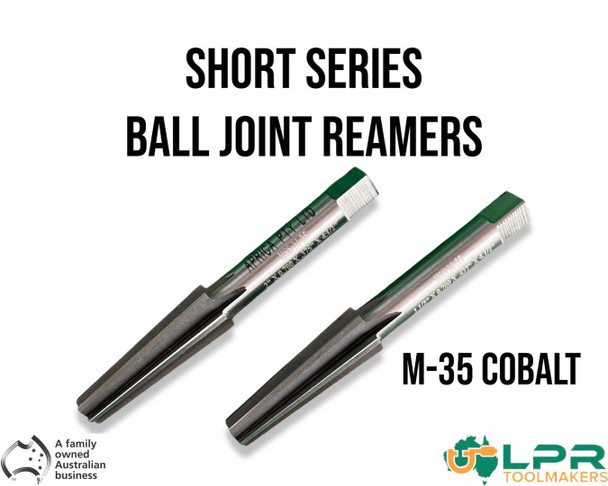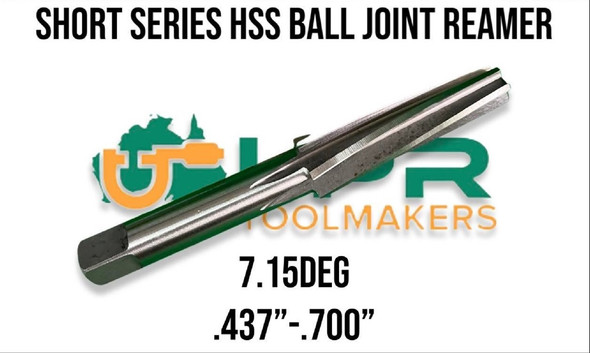Description
Aprica Tapered Spiral Fluted Ball Joint Hand Reamers
SUPER HIGH QUALITY PRODUCT
2 Size variations - choose up top.
A reamer is a type of rotary cutting Tools used in Metalwork. Precision reamers are designed to enlarge the size of a previously formed hole by a small amount but with a high degree of accuracy to leave smooth sides. There are also non-precision reamers which are used for more basic enlargement of holes or for removing burr’s. The process of enlarging the hole is called reaming. There are many different types of reamer and they may be designed for use as a hand tool or in a such as a Milling machine, or Drill Press.
|
No. |
Size |
Taper |
Small end |
Large end |
O/L Length |
|
2 |
2.0” Ft |
9.56 degrees |
3/8” 9.52mm |
.700" 17.78mm |
4.5” |
|
2.5 |
1/5”Ft |
7.15 degrees |
7/16” 11.12mm |
.700" 17.78mm |
4.5” |
|
Product Description |
|
Product Name |
HSS Spiral Flute Ball Joint Taper Reamer |
|
Material |
5% Cobalt High Speed Steel |
|
Shank |
Straight Shank |
|
Flute |
Spiral Flute |
|
Surface Finish |
Bright |
|
Package |
Plastic Tube. |
|
Features |
Tapered reamers will help align holes,
remove burrs from cut pipe, tubing, and Conduit,
and enlarge and Countersink holes in sheet metal, plastic, and other materials
Square drive design for easy turning and sure handling.
|
Here's a guide on determining which ball joint reamer you need for tie rods:
- Understand the purpose of the reamer: A ball joint reamer is a cutting tool used to enlarge the hole in a ball joint to allow for a larger diameter stud to be inserted. In the case of tie rods, a ball joint reamer is used to create a smooth and accurate hole for the ball joint stud to fit into.
- Measure the ball joint stud: The first step in determining which ball joint reamer you need is to measure the ball joint stud. The diameter of the stud should be measured with a micrometre to determine the size of the hole that needs to be reamed.
- Determine the required tolerance: Once you know the size of the stud, you need to determine the required tolerance. This is the amount of deviation from the exact size of the hole that is acceptable. The tolerance can vary depending on the specific application and the manufacturer's specifications.
- Choose the appropriate reamer: Based on the size of the stud and the required tolerance, you can choose the appropriate ball joint reamer. Ball joint reamers come in various sizes and tolerances, so it's important to select the correct one for your needs. It's also important to choose a high-quality reamer made from durable materials like high-speed steel or carbide to ensure accuracy and longevity.
- Ream the hole: Once you have the appropriate ball joint reamer, you can begin the reaming process. It's important to use proper technique and apply consistent pressure to achieve the desired results. The reaming process should be performed slowly and carefully to avoid damaging the tie rod or the reamer.
- Check the fit: Once the hole has been reamed, it's important to check the fit of the ball joint stud. The stud should fit snugly into the hole without any excess play or tightness. If the fit is not correct, additional reaming or other adjustments may be necessary.
In summary, determining the appropriate ball joint reamer for tie rods involves measuring the size of the stud, determining the required tolerance, selecting the appropriate reamer, performing the reaming process with care and precision, and checking the fit of the ball joint stud. With proper technique and the right tools, you can achieve accurate and precise results.
Reaming tie rods is a common process that is performed to ensure that the ball joint studs fit securely into the tie rod ends. Here's a guide on how to use a reamer on tie rods:
- Determine the required size: Before using a reamer on tie rods, it's important to determine the required size. This can be done by measuring the size of the ball joint stud using a micrometer. The reamer should be slightly larger than the size of the stud to ensure a proper fit.
- Choose the appropriate reamer: Based on the size of the ball joint stud and the required tolerance, choose the appropriate reamer. Ball joint reamers are available in various sizes and tolerances, so it's important to select the correct one for your needs.
- Secure the tie rod: To prevent damage to the tie rod during the reaming process, secure it in a vise or clamping device.
- Lubricate the reamer: Apply a lubricant to the reamer to ensure smooth and accurate cutting.
- Ream the hole: Slowly insert the reamer into the tie rod end and begin turning it clockwise. Apply steady pressure and keep the reamer lubricated. Check the hole frequently to ensure that the reamer is removing material evenly.
- Check the fit: Once the reaming process is complete, check the fit of the ball joint stud. The stud should fit snugly into the hole without any excess play or tightness. If the fit is not correct, additional reaming or other adjustments may be necessary.
- Clean the tie rod: After the reaming process is complete, clean the tie rod to remove any metal shavings or debris that may have accumulated during the reaming process.
In summary, using a reamer on tie rods involves determining the required size, choosing the appropriate reamer, securing the tie rod, lubricating the reamer, reaming the hole, checking the fit of the ball joint stud, and cleaning the tie rod. With proper technique and the right tools, you can achieve accurate and precise results.























![Taper Pin Reamer Set - 6pc [#0 to #5] 1:48 Ratio - Imperial Australian Supplier Taper Pin Reamer Set - 6pc [#0 to #5] 1:48 Ratio - Imperial Australian Supplier](https://cdn11.bigcommerce.com/s-c9l4hm6h/images/stencil/590x590/products/3733/12595/Taper_Pin_Reamers_-_6pc_Set_-_1__34347.1738557281.jpg?c=2)
![Taper Pin Reamer Set - 6pc [#0 to #5] 1:48 Ratio - Imperial Australian Supplier Taper Pin Reamer Set - 6pc [#0 to #5] 1:48 Ratio - Imperial Australian Supplier](https://cdn11.bigcommerce.com/s-c9l4hm6h/images/stencil/590x590/products/3733/12596/Taper_Pin_Reamers_-_6pc_Set_-_2__65140.1738557283.jpg?c=2)

